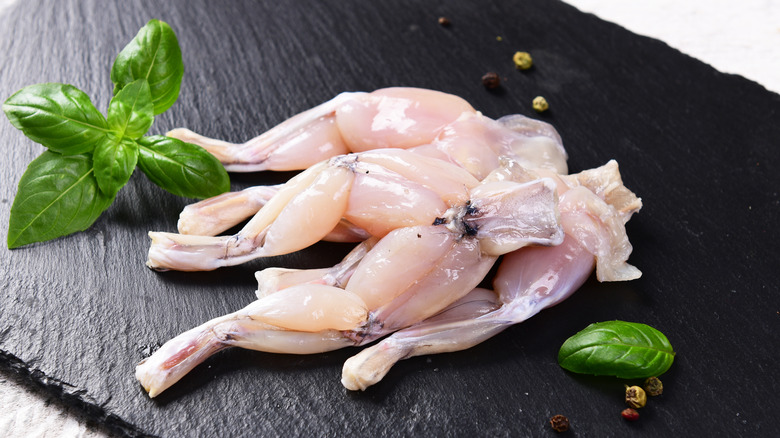The Real Reason Frogs' Legs May Soon Be Off The Menu
They are said to "look and taste like chicken wings" and are usually consumed either sauteed in butter with garlic and parsley, or encased in a light batter and fried, via Taste of France. Cuisses de grenouilles — or frogs' legs — are a delicacy in France and Belgium; so much so that there is even an annual fair in France where people pay tribute to the delicacy by consuming it in different ways beyond the traditional including in pizzas, quiches, omelets, and souffles, to name a few, per The Guardian. The global love of frogs' legs is such that 4,000 tonnes are consumed in France alone with nearly all the frogs coming from Indonesia.
While frogs (and toads) look like they are everywhere per Toads n Frogs, because many of them are either the wrong size or too toxic, only a handful of the more than 7,200 species of frogs and toads that we know of are fit for human consumption. While American Bullfrogs and Northern as well as Southern Leopard frogs are consumed in North America, the most in demand frogs for consumption is Indonesia's Javan Giant Frog, the Common Water Frog — which are both eaten in Europe — and the Anatolian Water Frog which is consumed in the Middle East. While the American bullfrog is farmed, the latter three frogs are caught in the wild and that demand, warn conservationists, is driving different frog species towards extinction.
Human appetite for frogs legs is causing a crisis
In a report by Germany's nonprofit organization Pro Wildlife and Robin des Bois of France state that the European Union (EU) buys between 81 to 200 million frogs for consumption every year. Many of these frogs are captured in the wild in Indonesia, Turkey, and Albania.
The groups state that there are multiple problems involved with buying and importing frogs this way. "In the 1980s, India and Bangladesh were the first to supply frogs' legs to Europe, but since the 1990s, Indonesia has taken over as the largest supplier," Pro Wildlife co-founder Dr. Sandra Altherr said. "In the Southeast Asian country, as now also in Turkey and Albania, large frog species are dwindling in the wild, one after the other, causing a fatal domino effect for species conservation."
Pro Wildlife is also concerned about the way the frogs are prepared for export. "Most frogs have their legs cut off with axes or scissors –- without anesthesia. The upper half is disposed of dying, the legs are skinned and frozen for export," Altherr says, per Pro Wildlife.
According to the International Union for the Conservation of Nature, amphibians are already under pressure because they are seen as "the most threatened group among vertebrates," per The Guardian. The groups are now hoping to convince the EU to consider and implement measures including an import restriction and imposing traceability for frogs' legs, which might help in giving the amphibians a fighting chance of survival.

